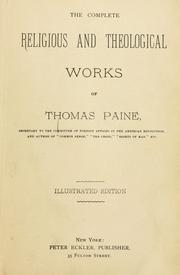Buy this book

Thomas Paine who was a dynamic philosophical presence in the American Revolution of 1776 wrote his last book in 1795 on an investigation and commentary of organized religion with a focus on Christianity. Paine said that his "religious duties" included doing justice, loving benevolence, and attempting to make others happy. He called himself a deist which is a person who believes in the existence of a God based on the evidence of reason and nature but not on supernatural revelation. In this book he outlines deism as a rational religious belief and offers an analysis of the Bible based on textual content. He makes comparisons of the internal arguments of the Old and New Testaments by explaining, for example, inconsistencies of the biographic accounts in the four gospels. Paine suggests that since they were written separate of each other their basis is no better than hearsay. Because the United States convicted Paine of seditious libel in 1792, he escaped to France where he was selected to be a member of its National Convention. But there he conflicted with Robespierre, and while awaiting his arrest he wrote the first part of "The Age of Reason." Afterwards he was confined in Luxembourg and wrote the second half of the book. The work was published in 1795 and serves as a criticism of established religion from the point of view of the 18th century deists. Paine's clear and concise understanding of the development of the Christian religion from its pagan origins is especially significant when the reader examines the interconnecting references and implications of superstition and fallacy that are still involved in any ceremonial aspect. And, finally, Thomas Paine explains the answer to any confrontation best of all: "The most formidable weapon against errors of every kind is Reason."Please Note: This book is easy to read in true text, not scanned images that can sometimes be difficult to decipher. The Microsoft eBook has a contents page linked to the chapter headings for easy navigation. The Adobe eBook has bookmarks at chapter headings and is printable up to two full copies per year. Both versions are text searchable.
Buy this book

Previews available in: English Yiddish
Subjects
Rationalism, Early works to 1800, Theology, Reason, Prophecies, Controversial literature, Bible, Messiahship, Philosophy and religion, Christianity, Messiah, Nonfiction, Philosophy, Religion & Spirituality, Essays, Rationalism and free thought, Rationalisme, Philosophie et religion, Political sciencePeople
Thomas Paine (1737-1809), Jesus ChristShowing 8 featured editions. View all 56 editions?
| Edition | Availability |
|---|---|
|
1
The Age of Reason: Being an Investigation of True and Fabulous Theology
1896, G. P. Putnam's Sons
Hardcover
in English
|
bbbb
Libraries near you:
WorldCat
|
| 2 |
bbbb
|
| 3 |
aaaa
|
| 4 |
bbbb
Libraries near you:
WorldCat
|
| 5 |
bbbb
|
| 6 |
bbbb
|
| 7 |
bbbb
|
| 8 |
bbbb
|
Book Details
Published in
New York
Table of Contents
Edition Notes
The Physical Object
ID Numbers
Community Reviews (0)
Feedback?| August 17, 2022 | Edited by ImportBot | import existing book |
| July 22, 2019 | Edited by MARC Bot | remove fake subjects |
| November 23, 2012 | Edited by Anand Chitipothu | Reverted spam |
| November 21, 2012 | Edited by 188.190.127.71 | Edited without comment. |
| October 16, 2009 | Created by WorkBot | add works page |




















